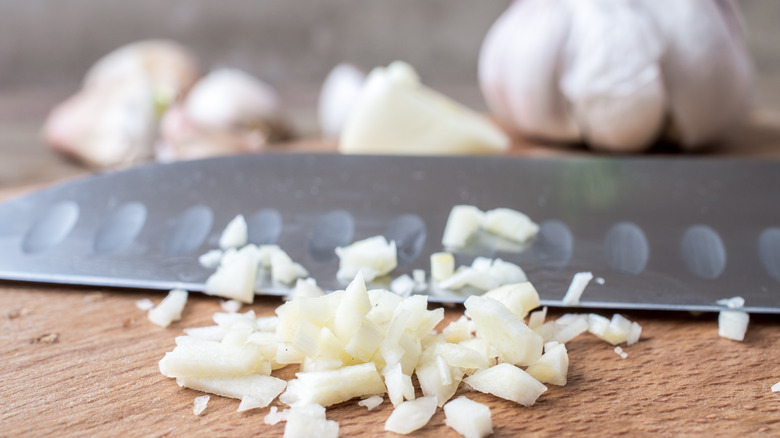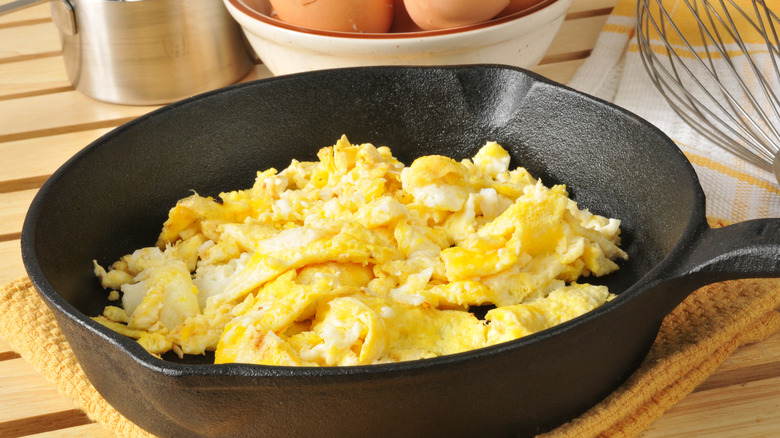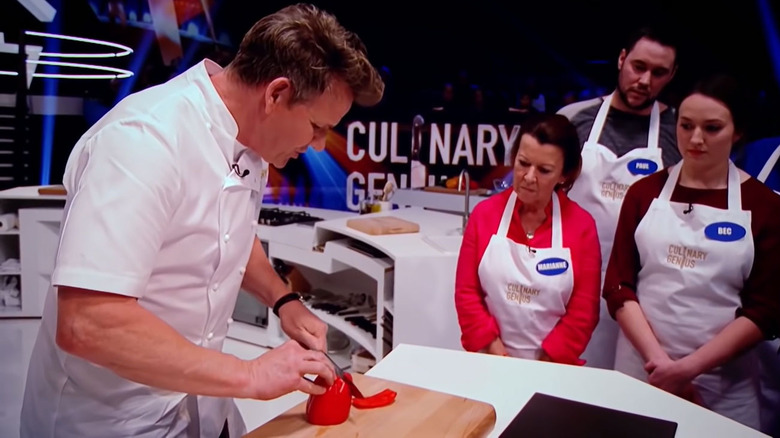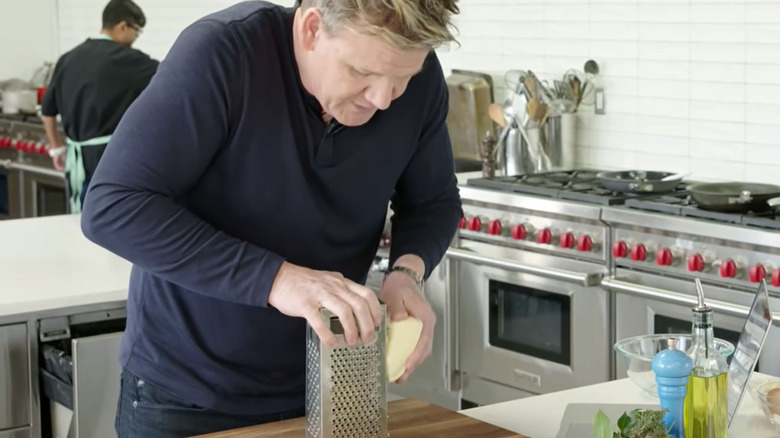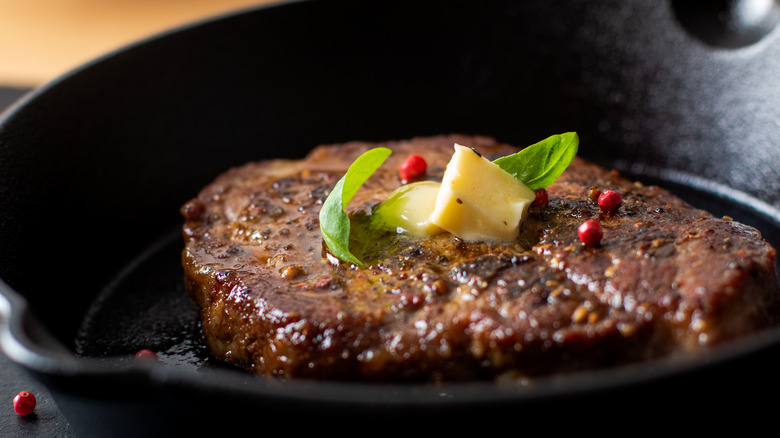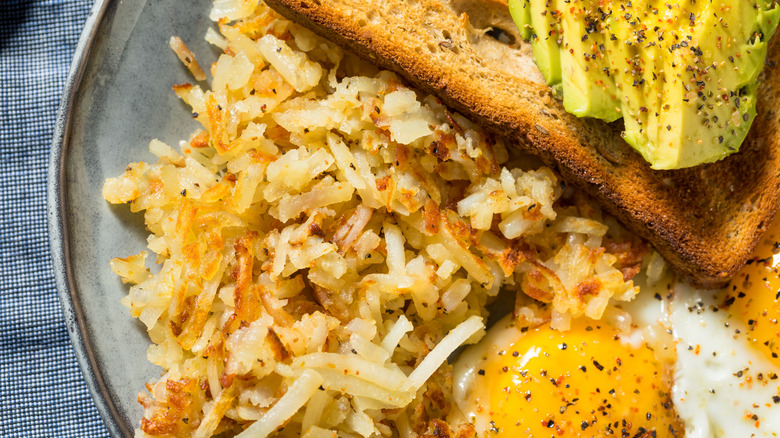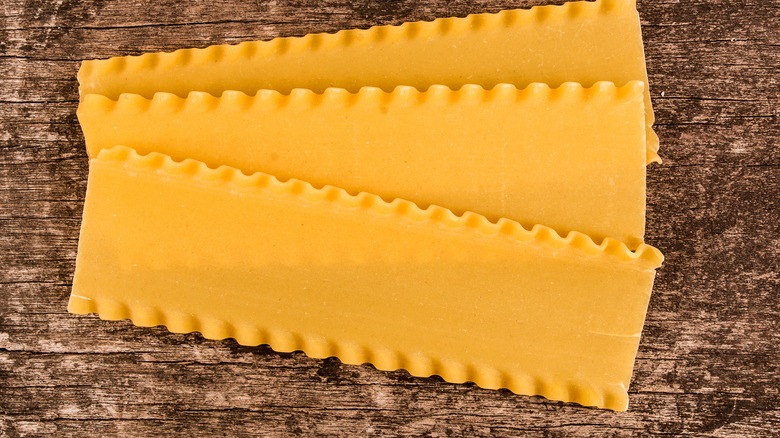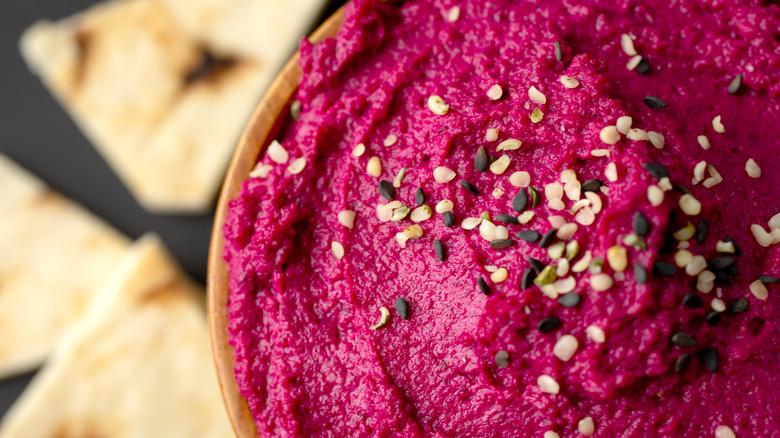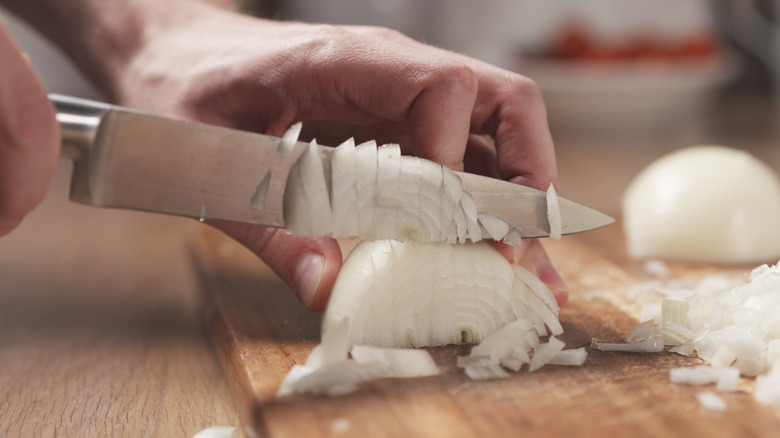The Best Cooking Tips From Gordon Ramsay
You know him as the always-angry Scottish chef behind some of the most over-the-top cooking shows of all time, including Hell's Kitchen, Kitchen Nightmares, and MasterChef. You've looked up the Idiot Sandwich meme to see if it's real. You're very much aware of Gordon Ramsay and his tireless and much-televised pursuit of culinary perfection. But he's far from just a trumped-up, expletive-spouting TV personality.
A multiple Michelin star-winning talent of the highest order, Ramsay knows his stuff. But you don't have cook fine French cuisine or his famous beef Wellingtons every night to learn from what he has to offer online. On top of his many other claims to fame, Ramsay is a bonafide YouTube star, with hundreds of videos demonstrating simple tips, tricks, and recipes for cooks of all ages and skill levels. From efficiently dicing onions to whipping up unconventional Middle Eastern fare, here are some of the finest cooking tips from the one and only Gordon Ramsay.
Mince garlic without a press
Need to mince garlic into a potent paste with no press on hand? Gordon's got you covered with a simple trick using something no respectable chef should ever be without: salt. As Ramsay demonstrates, all you have to do is thwack the garlic clove with the back of your trusty chef's knife, remove that pesky skin, then chop the garlic up into a sticky paste with an assist from a sprinkle of coarse salt to help break it all down.
Ramsay notes that the salt also acts like a binding agent and prevents all that garlicky goodness from oozing out onto your cutting board. Plus, you're most likely using salt in whatever dish you need the garlic for, so depending on your salt needs, you might be one step ahead of the seasoning game. But remember to adjust the dish's overall salt content accordingly when using this helpful hack — especially if you're prone to overdoing it with the Morton's.
Scramble luxuriously creamy eggs
If you grew up eating scrambled eggs as dry and unyielding as a kitchen sponge, Gordon Ramsay's impossibly creamy recipe may come as a shock. Is this how scrambled eggs are supposed to taste? Ramsay sure thinks so, citing nailing this style of preparation as one of the first tests he gives chefs looking to work in his restaurant empire.
The secret is intermittently exposing the eggs to the heat, stirring all the while. Ramsay also advises not to season the eggs in advance, lest they get too watery. But it's not just about treating eggs like risotto: You also add a spoonful of tangy crème fraiche and freshly-chopped chives at the end, elevating the humble scrambled egg into something "sexy," according to Ramsay. He suggests serving his seductive scramble on sourdough toast with whole flat-cap mushrooms and tomatoes on the vine — two gorgeous sides made even lovelier by how unbelievably simple they are to cook, freeing you to focus on giving the eggs the attention they need.
Cut bell peppers to perfection
If you tend to rush your bell pepper prep and leave seeds and pith behind, Gordon's guide to pepper perfection is the intervention you need. He takes having a super-sharp knife as a given here, but for many home cooks, that's step number one: Make sure your knife is up to the task. A dull blade simply won't achieve the results Ramsay demonstrates. He cuts through these peppers like Paulie cuts garlic in Goodfellas, except with an actual chef's knife instead of, y'know, contraband.
Notice how Ramsay avoids the mess by simply leaving the seeds undisturbed inside the pepper, slicing off those pith-free cheeks of crunchy goodness carefully. To make the task less of a hassle, Ramsay slices off the "top and tail," creating a flat bottom for the pepper to rest on. Once the waste is out of the way, Ramsay advises cutting the peppers skin-side down for the best results, whether you're dicing, julienning, or cutting thick batons for stir-frys or salads.
Cleanly grate mozzarella
If you've watched Kitchen Nightmares, you know that Gordon Ramsay hates being served frozen food. In fact, "frozen" is an "F" word that Ramsay rarely deploys, unless he's quizzing clueless cooks about a particularly unappetizing appetizer. But a freezer can be useful for more than just leftovers, desserts, and ill-advised culinary shortcuts. It can also be used, surprisingly, to help grate a soft cheese like mozzarella without crushing it.
To cleanly grate a block of mozzarella, Ramsay suggests sticking it in the freezer for ten minutes to get it nice and firm. But it's about more than just a clean mise en place. Subjecting the cheese to the icy air of your freezer pre-grating also leads to a greater yield, meaning more of that pricy product is ending up where it belongs. It's a dead simple trick, but Ramsay also helpfully notes that it's important to remember to use the entire surface area of the grater and to flip the cheese periodically as you grate.
Cook a perfect steak without a grill
Many stubborn steak-lovers insist on open flames, but it's possible to make a juicy, perfectly-seasoned steak indoors in a pan, as Ramsay demonstrates. What you lose in smokiness you gain in flavor elsewhere; after all, you can't baste your steak in garlic, thyme, and a generous knob of butter on a grill without losing all that loveliness to the fire.
Ramsay's method is a master course in miniature, with at least a half-dozen useful takeaways. There's the handy "palm test" to measure doneness, the reminder to always "lay away" when working with a hot pan, and several tips to get an excellent sear, including using a mix of olive oil and butter and using the side of the pan to your advantage (another technique impossible on the grill). He also shares a nugget of culinary wisdom here even vegans can appreciate: Never add oil to a pan until it's hot, unless you actually want to boil your food in a thin layer of fat, rather than give it a flavorful sear with a proper sauté.
Chop herbs mess-free
It's tempting to treat fresh herbs as an afterthought, roughly chopping or even tearing them at the last minute to add a final flourish. Where's the harm? As Ramsay preaches in "Culinary Genius," this absent-minded approach actually leaves a lot of flavor on the cutting board (or on your fingers) instead of in your dish.
There's a simple way to tell if you're being too rough on your herbs, according to Ramsay: Your cutting board turns a sickly shade of green. That stain doesn't just mean more scrubbing for you later on — it's evidence that much of the flavor of the herbs was extracted via your brutish "pressurizing," as Ramsay puts it. The best approach is a delicate one, whether you're carefully cutting chives into tiny cylinders or using the classic "cigar trick" to chiffonade basil. You wouldn't press down on a burger patty mid-grilling, sending all that juiciness into the fire; Ramsay advises you treat your potent, succulent, and often expensive fresh herbs with the same respect.
Cook restaurant-perfect hash browns
How does a world-class chef handle a rustic American favorite like hash browns? With great care and attention to detail, but zero fuss. At the heart of Ramsay's simple hash browns are waxy potatoes, onions, and cayenne pepper, as you'd expect, but it's his technique that elevates this standard breakfast fare.
To start, Ramsay grates both the potatoes and the onions for an extra-crispy, flavor-packed hash brown experience in every bite. It's crucial to squeeze as much water out of the mix as you can, Ramsay notes, to get the desired texture in the final product. Ramsay uses both olive oil and butter to deliver an enticing sear as well as bring a creamy richness to center of the potato/onion mix.
His most ingenious tip here is the plate trick: To cleanly flip your perfect discus of deliciousness, simply place a large dinner plate over the pan, then turn it over. To cook the unseared side of the hash browns, slide them off the plate and back into the pan. The result is an evenly cooked plate of pure Americana, courtesy of one of the world's most famous Scots.
Use lasagna noodles outside of a lasagna
There's a lot to love in Ramsay's mushroom, leek and tarragon pasta recipe, but his choice of noodle takes it over the top. Rather than relegate store-bought lasagna sheets to the time-consuming, oven-baked classic, Ramsay uses them here for a brilliant and unusual take on pasta that's sure to impress, if not befuddle. Your Italian grandmother may not approve, but adventurous diners will likely be wowed by this rustic-yet-luxurious delight.
The square lasagna sheets absorb so much of his rich, cream-based sauce that they become "stained" with it, to use Ramsay's word. The end result looks like a deconstructed lasagna swimming in sauce, with a perfect trio of mushrooms, leeks, and fresh tarragon peeking out. Ramsay wisely serves his saucy innovation with thick, crusty grilled bread rubbed in garlic to help mop up all that sauce. It may be unconventional, but it's hard to argue with the flavors, presentation, or simplicity of this twist on an Italian comfort food classic.
Whip up a beet-based hummus
A humble bowl of hummus will never be the talk of the dinner party, but Ramsay's beet-based beauty elevates the Middle Eastern favorite into a stunning centerpiece. The beets turn the dip the color of White Zinfandel, while the ingenious use of fresh marjoram adds a mintiness to balance out the root vegetable's trademark earthiness.
For best results, follow Ramsay's recipe, toasting your own cumin seeds and tracking down sumac, with delivers a unique tartness you can't get with anything else (though lemon zest will do in a pinch). It's convenient to fill your fridge with tubs of Sabra, but nothing store-bought compares to the umami-filled awesomeness of freshly-cooked chickpeas and high-end tahini, balanced by several generous squeezes of fresh lemon juice to brighten the bittersweetness of the beets. Bonus tip: Note how Ramsay rolls his lemon firmly on the cutting board before slicing it to extract as much juice as possible.
Finely chop an onion with zero waste
Gordon Ramsay's approach to chopping an onion is industry-standard, but he delivers the core lesson with his trademark brevity, packing a whole lot of knowledge into the video's 1:15 runtime. As in his bell pepper presentation, Ramsay omits needling viewers about the need for a sharp knife, but it's clear he's working with a blade sharpened to perfection. After peeling your onion, Ramsay notes it's crucial you leave the root intact, unless you enjoy crying into your stew. Lopping off the root, warns Ramsay, allows the onion to "bleed" its most potent cry-inducing juices.
Tears safely at bay, the rest of the operation involves delicately criss-crossing the onion into a fine dice, all the way up to the root. If you've always taken a more "rustic" approach to prepping your onions for the pan, it's worth practicing Ramsay's more refined technique until it's second nature. Not only do you get a higher yield and finer dice, you also avoid interrupting your workflow with an unwelcome onion-inspired jag.

